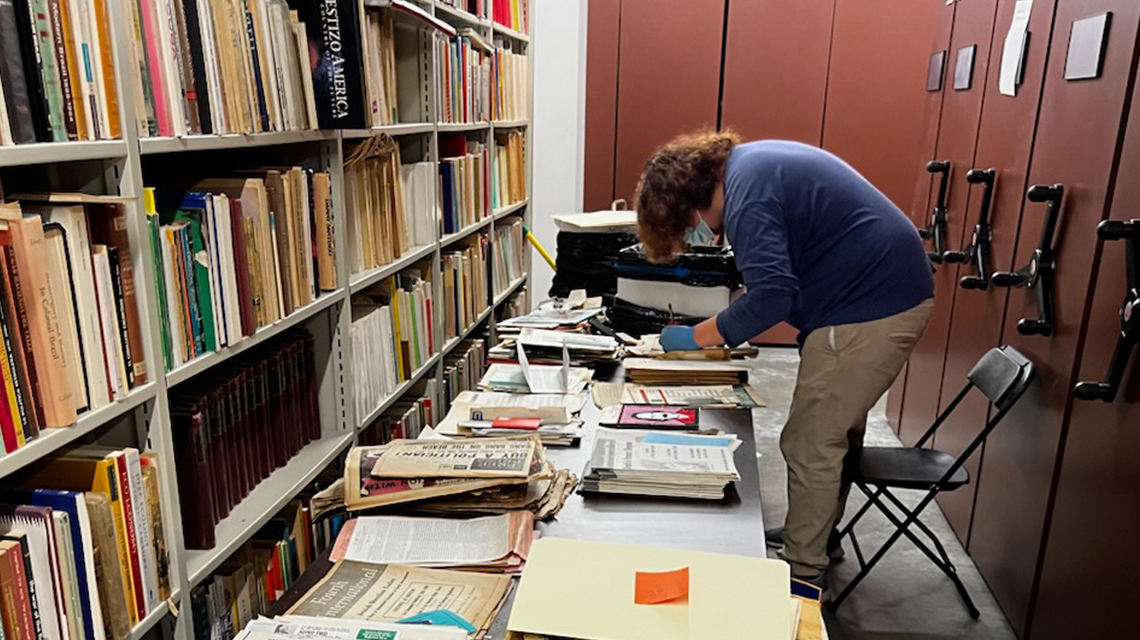
The Art Kunkin Los Angeles Free Press Collection is now available for research at the Gerth Archives and Special Collections at CSUDH, after three years of work and valuable assistance from the National Historical Publications and Record Commission and the Haynes Foundation. The collection spans 1928 to 2020 and contains 551 boxes of business records and personal papers of Kunkin and the Free Press. Archives staff have generated a 380-page finding aid/collection guide.
Although Kunkin (1928-2019) has largely faded from the history of journalism in California, he is an important figure in the rise of the U.S. underground press. Kunkin was a promoter, socialist, new age enthusiast, and the founding publisher of the Free Press—the first underground newspaper of the 1960s. It paved the way for thousands of underground newspapers in the U.S. between 1964 and 1975.
At its peak, the Free Press had a weekly readership of 100,000. The paper revolutionized investigative journalism and was at the forefront of promoting the music and sexual revolutions of the 1960s. They had community members cover the news—Black reporters covered the Watts Rebellion, for example. The Free Press helped pave the way for the more personal or “new” journalism of the 1970s, and served as a mouthpiece for the growing counterculture, student rights, anti-war, and civil rights movements of the era.
In 2021, during the COVID-19 pandemic and in the sweltering July heat of the high desert, Greg Williams, director of the Gerth Archives, and staff went out to the grounds of the Institute of Mentalphysics in Joshua Tree, Calif., where Kunkin had spent the last 20 years of his life. His papers and books were stored haphazardly—in a container, a barn, a trailer home, on slats exposed to the desert sun, and in a tin shed. Despite having been nibbled on by desert vermin, it became apparent that there were archival treasures in the mix. Staff from the Gerth Archives spent two days re-boxing the collection.
“The disorganization was monumental and an amazing archival challenge,” said Williams. “It was not clear if or when the file cabinets on the trailer home porch would cave in. Eventually, despite piles of swirling paper, rat-eaten confetti, and portions of documents eaten by other desert wildlife, we were able to gather the papers and returned to CSUDH with what we hoped was a coherent collection.”
The cataloged collection totals 551 boxes of material from Kunkin’s life—from his time as a socialist and labor organizer to his role as editor/publisher of the Free Press. It also includes editorial work related to his life as an esotericist, metaphysical educator, and alchemist (yes, alchemist).
“The wealth of this collection’s content with its themes of freedom of the press, the counterculture, a multicultural America, and New Age materials has made it a very rewarding experience to catalog,” said Free Press Project Archivist, Lucas Madrigal. “There are thousands of topics for students and other researcher to dive into.”
Despite sitting in the desert for 20 years, the papers were in relatively good shape and the processing has revealed a rich collection of counter-culture life. While Kunkin’s lifelong interest in politics, journalism, and spirituality are apparent in the papers, the collection also includes materials on the Black Power movement, music of the 1960s, the Chicano Movement, anti-war protests, the youth movement’s interactions with authorities, and much more on important political issues of the 1960s and 1970s.
An extensive LibGuide has been developed for the collection and includes a collections description, selected books on the history of the underground press, related resources, and a Free Press timeline. Additionally, a lesson plan for teaching the history of the Los Angeles Free Press for grades 11 through 16 has been developed by consultant Maureen Burns.
Beyond the physical processing, the project also digitized over 4,000 items from the collection. This includes memos, letters to the editors, original artwork and cartoons, photographic prints and slides, posters, and scrapbooks. Over 300 of those items are currently viewable in CSUDH digital collections, and much more will be digitized over the next few years.








